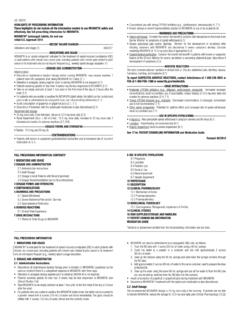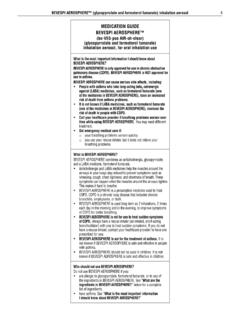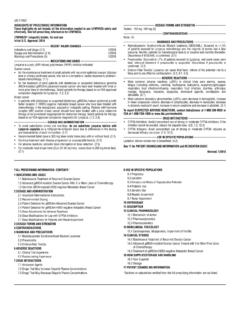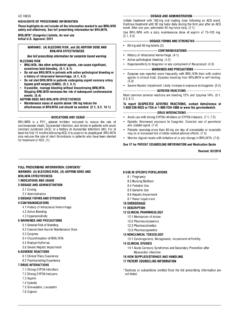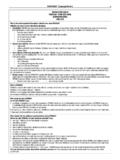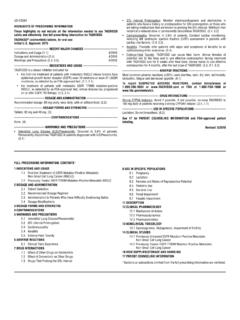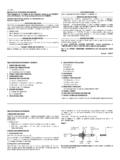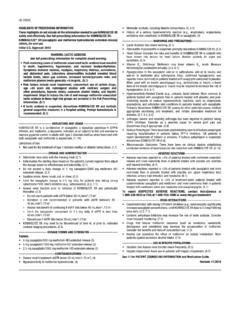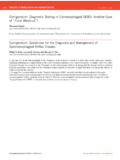Transcription of HIGHLIGHTS OF PRESCRIBING INFORMATION …
1 US-21559. HIGHLIGHTS OF PRESCRIBING INFORMATION Clostridium difficile-Associated Diarrhea: PPI therapy may be associated with These HIGHLIGHTS do not include all the INFORMATION needed to use NEXIUM safely and increased risk. ( ). effectively. See full PRESCRIBING INFORMATION for NEXIUM. Bone Fracture: Long-term and multiple daily dose PPI therapy may be associated with an increased risk for osteoporosis-related fractures of the hip, wrist or spine. ( ). NEXIUM (esomeprazole magnesium) delayed-release capsules, for oral use Cutaneous and Systemic Lupus Erythematosus: Mostly cutaneous; new onset or NEXIUM (esomeprazole magnesium) for delayed-release oral suspension exacerbation of existing disease; discontinue NEXIUM and refer to specialist for Initial Approval: 1989 (omeprazole) evaluation.
2 ( ). -------------------------------------REC ENT MAJOR CHANGES--------------------------------- -- Interaction with Clopidogrel: Avoid concomitant use of NEXIUM. ( ). Warnings and Precautions, Fundic Gland Polyps ( ) 06/2018 Cyanocobalamin (Vitamin B-12) Deficiency: Daily long-term use ( , longer than 3 years) may lead to malabsorption or a deficiency of cyanocobalamin. ( ). -------------------------------------IND ICATIONS AND USAGE----------------------------------- - Hypomagnesemia: Reported rarely with prolonged treatment with PPIs. ( ). NEXIUM is a proton pump inhibitor indicated for the following: Interaction with St. John's Wort or Rifampin: Avoid concomitant use of NEXIUM. Treatment of gastroesophageal reflux disease (GERD).
3 ( ) ( , ). Risk reduction of NSAID-associated gastric ulcer. ( ) Interactions with Diagnostic Investigations for Neuroendocrine Tumors: Increased H. pylori eradication to reduce the risk of duodenal ulcer recurrence. ( ) chromogranin A (CgA) levels may interfere with diagnostic investigations for Pathological hypersecretory conditions, including Zollinger-Ellison syndrome. ( ) neuroendocrine tumors, temporarily stop NEXIUM at least 14 days before assessing CgA levels. ( , ). ---------------------------------DOSAGE AND ADMINISTRATION-------------------------- ------ Interaction with Methotrexate: Concomitant use with PPIs may elevate and/or prolong Indication Dose Frequency serum concentrations of methotrexate and/or its metabolite, possibly leading to gastroesophageal Reflux Disease (GERD) toxicity.
4 With high dose methotrexate administration, consider temporary withdrawal Adults 20 mg or 40 mg Once daily for 4 to 8 weeks of NEXIUM. ( , ). 12 to 17 years 20 mg or 40 mg Once daily for up to 8 weeks Fundic Gland Polyps: Risk increases with long-term use, especially beyond one year. 1 to 11 years 10 mg or 20 mg Once daily for up to 8 weeks Use the shortest duration of therapy. ( ). 1 month to less than 1 year: mg, 5 mg or 10 mg (based on weight). Once daily, ---------------------------------------A DVERSE REACTIONS------------------------------- -------- up to 6 weeks for erosive esophagitis (EE) due to acid-mediated GERD only. Most common adverse reactions ( ): Risk Reduction of NSAID-Associated Gastric Ulcer Adults ( 18 years) (incidence 1%) are headache, diarrhea, nausea, flatulence, 20 mg or 40 mg Once daily for up to 6 months abdominal pain, constipation, and dry mouth.
5 H. pylori Eradication (Triple Therapy): Pediatric (1 to 17 years) (incidence 2%) are headache, diarrhea, abdominal pain, NEXIUM 40 mg Once daily for 10 days nausea, and somnolence. Amoxicillin 1000 mg Twice daily for 10 days Pediatric (1 month to less than 1 year) (incidence 1%) are abdominal pain, regurgitation, Clarithromycin 500 mg Twice daily for 10 days tachypnea, and increased ALT. Pathological Hypersecretory Conditions To report SUSPECTED ADVERSE REACTIONS, contact AstraZeneca at 1-800-236-9933. 40 mg Twice daily or FDA at 1-800-FDA-1088 or See full PRESCRIBING INFORMATION for administration options. (2) ---------------------------------------- DRUG INTERACTIONS---------------------------- ---------- Patients with severe liver impairment-do not exceed dose of 20 mg.
6 (2) May affect plasma levels of antiretroviral drugs use with atazanavir and nelfinavir is not recommended; if saquinavir is used with NEXIUM, monitor for toxicity and -------------------------------DOSAGE FORMS AND STRENGTHS------------------------------- consider saquinavir dose reduction. ( ). NEXIUM Delayed-Release Capsules: 20 mg and 40 mg. (3). May interfere with drugs for which gastric pH affects bioavailability ( , ketoconazole, NEXIUM For Delayed-Release Oral Suspension: mg, 5 mg, 10 mg, 20 mg, and iron salts, erlotinib, digoxin and mycophenolate mofetil). Patients treated with 40 mg. (3) NEXIUM and digoxin may need to be monitored for digoxin toxicity. ( ). ---------------------------------------C ONTRAINDICATIONS------------------------ --------------- Combined inhibitor of CYP2C19 and 3A4 may raise esomeprazole levels.
7 ( ). Patients with known hypersensitivity to proton pump inhibitors (PPIs) (angioedema and Clopidogrel: NEXIUM decreases exposure to the active metabolite of clopidogrel. ( ). anaphylaxis have occurred). (4) May increase systemic exposure of cilostazol and an active metabolite. Consider dose reduction. ( ). ---------------------------------WARNING S AND PRECAUTIONS----------------------------- ---- Tacrolimus: NEXIUM may increase serum levels of tacrolimus. ( ). Gastric Malignancy: In adults, symptomatic response does not preclude the presence Methotrexate: NEXIUM may increase serum levels of methotrexate. ( ). of gastric malignancy. Consider additional follow-up and diagnostic testing. ( ). Acute Interstitial Nephritis: Observed in patients taking PPIs.
8 ( ) See 17 for PATIENT COUNSELING INFORMATION and Medication Guide Revised: 06/2018. FULL PRESCRIBING INFORMATION : CONTENTS*. 1 INDICATIONS AND USAGE Interaction with Methotrexate 12 CLINICAL PHARMACOLOGY. Treatment of gastroesophageal Reflux Disease Fundic Gland Polyps Mechanism of Action (GERD) 6 ADVERSE REACTIONS Pharmacodynamics Risk Reduction of NSAID-Associated Gastric Ulcer Clinical Trials Experience Pharmacokinetics H. pylori Eradication to Reduce the Risk Postmarketing Experience Microbiology of Duodenal Ulcer Recurrence 7 DRUG INTERACTIONS 13 NONCLINICAL TOXICOLOGY. Pathological Hypersecretory Conditions Including Interference with Antiretroviral Therapy Carcinogenesis, Mutagenesis, Impairment Zollinger-Ellison Syndrome Drugs for Which Gastric pH Can Affect of Fertility 2 DOSAGE AND ADMINISTRATION Bioavailability Animal Toxicology and/or Pharmacology 3 DOSAGE FORMS AND STRENGTHS Effects on Hepatic Metabolism/Cytochrome 14 CLINICAL STUDIES.
9 4 CONTRAINDICATIONS P-450 Pathways Healing of Erosive Esophagitis 5 WARNINGS AND PRECAUTIONS Interactions with Investigations of Symptomatic gastroesophageal Reflux Disease Presence of Gastric Malignancy Neuroendocrine Tumors (GERD). Acute Interstitial Nephritis Tacrolimus Pediatric gastroesophageal Reflux Disease Clostridium difficile-Associated Diarrhea Combination Therapy with Clarithromycin (GERD). Bone Fracture Methotrexate Risk Reduction of NSAID-Associated Gastric Ulcer Cutaneous and Systemic Lupus Erythematosus 8 USE IN SPECIFIC POPULATIONS Helicobacter pylori (H. pylori) Eradication in Interaction with Clopidogrel Pregnancy Patients with Duodenal Ulcer Disease Cyanocobalamin (Vitamin B-12) Deficiency Lactation Pathological Hypersecretory Conditions Including Hypomagnesemia Pediatric Use Zollinger-Ellison Syndrome Interaction with St.
10 John's Wort or Rifampin Geriatric Use 16 HOW SUPPLIED/STORAGE AND HANDLING. Interactions with Diagnostic Investigations for 10 OVERDOSAGE 17 PATIENT COUNSELING INFORMATION . Neuroendocrine Tumors 11 DESCRIPTION *Sections or subsections omitted from the full PRESCRIBING INFORMATION are not listed. FULL PRESCRIBING INFORMATION Please refer to amoxicillin and clarithromycin PRESCRIBING INFORMATION for Contraindications, 1 INDICATIONS AND USAGE Warnings, and dosing in elderly and renally-impaired patients. Treatment of gastroesophageal Reflux Disease (GERD) Specific Populations Healing of Erosive Esophagitis Hepatic Insufficiency NEXIUM is indicated for the short-term treatment (4 to 8 weeks) in the healing and In patients with mild to moderate liver impairment (Child-Pugh Classes A and B), no symptomatic resolution of diagnostically confirmed erosive esophagitis.
